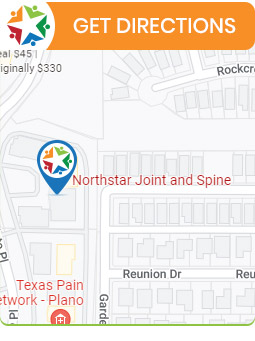Post-Laminectomy Syndrome Specialist in Plano, TX
Post-laminectomy syndrome, also known as failed back surgery syndrome, refers to chronic pain that persists after back surgery, particularly a laminectomy. This condition can cause ongoing discomfort in the back and legs, often due to nerve damage, scar tissue, or spinal instability. Effective treatment requires a personalized approach to manage pain and improve mobility. Board-Certified Dr. Robert J. Nocerini, MD, at Northstar Joint and Spine offers specialized care for this condition. Contact us today for more information or schedule an appointment online. We are conveniently located at 7704 San Jacinto Pl Suite #200 Plano, TX 75024.


Table of Contents:
What is post laminectomy syndrome?
What causes post laminectomy syndrome?
What are the symptoms of post laminectomy syndrome?
What treatments are available for post laminectomy syndrome?
Is post-laminectomy syndrome a chronic condition?
Comprehensive Post-Laminectomy Syndrome Care from Dr. Robert Nocerini at Northstar Joint and Spine in Plano, TX
Post-laminectomy syndrome, also known as failed back surgery syndrome (FBSS), refers to the persistence of chronic pain following back surgery, particularly after a laminectomy. A laminectomy is a procedure where part of the vertebrae, called the lamina, is removed to relieve pressure on the spinal cord or nerves. While this surgery is intended to alleviate pain caused by spinal conditions, some patients may experience continued discomfort or the return of pain, which can be debilitating.
The pain associated with post-laminectomy syndrome can affect the back, legs, or both and may vary in intensity. It is often characterized by a deep, aching pain that may be accompanied by numbness, tingling, or weakness in the affected areas. The cause of this syndrome can be multifactorial, including nerve damage, the formation of scar tissue, or the progression of degenerative spinal conditions.
Although post-laminectomy syndrome can be challenging to treat, various interventions, including physical therapy, medications, spinal injections, and in some cases, further surgeries, may help manage the symptoms. However, the condition requires careful evaluation and individualized treatment plans tailored to each patient’s needs.
There are several factors that can explain why back pain persists after surgery. The most common causes of post-laminectomy syndrome (failed back surgery syndrome) include nerve root compression or a recurrent disc herniation. In addition to these, other factors may contribute to continued pain, including depression, anxiety, smoking, insomnia, and the release of inflammatory mediators. Some additional causes include:
• Diabetes: Can interfere with the healing process and increase pain sensitivity.
• Scar tissue formation: Scar tissue can form around nerves and lead to persistent pain.
• Spinal instability: Insufficient spinal support after surgery may lead to ongoing discomfort.
• Facet joint problems: Dysfunction in the joints between vertebrae can cause pain and limited mobility.
• Autoimmune disorders: These conditions can affect recovery and lead to chronic inflammation.
• Joint hypermobility: Excessive movement in the spinal joints can lead to instability and pain.
• Smoking: Nicotine can slow bone healing and promote scar tissue buildup, worsening pain.
Identifying the exact cause of pain is crucial for determining the right treatment and improving recovery outcomes.
Post-laminectomy syndrome (failed back surgery syndrome) is often associated with persistent, chronic pain that can be distressing and debilitating. It is estimated that nearly 20% of patients who undergo back surgery continue to experience some form of pain or discomfort long after their procedure. Symptoms can vary but typically include:
• Neuropathic pain: This type of pain is characterized by sharp, stabbing, or burning sensations that are similar to the pain experienced during the original spinal damage. It results from nerve damage or irritation.
• Radicular pain: This occurs due to inflammation of the nerve root, leading to shooting or radiating pain that travels along the path of the affected nerve.
• Leg pain: Pain that radiates down the legs, often caused by nerve compression or irritation, is common in those with post-laminectomy syndrome.
• Dull, achy pain: Persistent, aching discomfort in the spinal column, especially in the area of the previous surgery, is another symptom. This can feel like a constant pressure or heaviness in the lower back or spine.
These symptoms can significantly impact a patient’s daily life, leading to chronic distress and reduced functionality. Effective diagnosis and treatment are crucial in managing these ongoing issues.
Chronic back pain from post-laminectomy syndrome can be incredibly challenging, making simple tasks seem impossible. It can interfere with daily life, causing discomfort when sitting, standing, or even working. Identifying the source of your pain is key to developing an effective treatment plan. Fortunately, there are various treatment options available to help manage the pain, including:
• Physical therapy and specialized exercises: These can help strengthen muscles, improve flexibility, and relieve strain on the spine, which can reduce pain over time.
• NSAIDs (nonsteroidal anti-inflammatory drugs): Over-the-counter medications like ibuprofen or prescription-strength NSAIDs can reduce inflammation and alleviate mild to moderate pain.
• Spinal cord stimulation: This involves an implanted device that sends mild electrical pulses to the spinal cord, helping to block pain signals and provide relief.
• Epidural nerve block: Injections of medication directly into the epidural space around the spinal cord can help reduce inflammation and provide significant pain relief.
• Facet joint injections: These are used to target inflammation in the facet joints of the spine, which can help reduce pain in the back and legs.
• Radiofrequency neurotomy: This technique uses heat to target and interrupt nerve signals causing pain, particularly from the facet joints.
These treatments, combined with patience and time, can help patients regain control over their lives and manage the discomfort associated with post-laminectomy syndrome. Each treatment plan is personalized based on the severity of symptoms and the patient’s overall health.
Post-laminectomy syndrome (failed back surgery syndrome) is often considered a chronic condition. It refers to the persistence of pain after back surgery, particularly following a laminectomy, a procedure that removes part of the vertebrae to relieve pressure on the spinal cord or nerves. While the surgery is intended to alleviate pain, some patients continue to experience discomfort long after the procedure, making it a long-term condition in many cases.
The pain from post-laminectomy syndrome can be debilitating and may affect the back, legs, or both. It is typically characterized by nerve pain, radicular pain, and dull, achy discomfort in the spinal column. In some instances, this pain may even worsen over time due to complications such as scar tissue buildup, nerve damage, or spinal instability.
Although it is not guaranteed to persist indefinitely, many patients struggle with chronic pain for years after surgery. However, treatment options such as physical therapy, medications, spinal injections, and advanced procedures like spinal cord stimulation can help manage symptoms. While the pain may not always resolve completely, these treatments can significantly improve the quality of life for individuals dealing with this chronic condition.
Board-Certified Dr. Robert Nocerini, MD at Northstar Joint and Spine offers effective solutions for patients living with post-laminectomy syndrome in Plano, TX. This condition can occur after spinal surgery, resulting in lingering discomfort or stiffness. Dr. Nocerini’s expertise allows him to accurately identify the nerve sources responsible for persistent pain and use advanced, non-surgical treatments to help patients regain mobility and comfort.
Dr. Nocerini designs individualized pain management strategies that may include nerve stimulation, targeted injections, or radiofrequency treatments to reduce pain intensity. His goal is to help patients achieve long-term relief and restore their quality of life. Known for his patient-focused care, Dr. Nocerini combines experience, precision, and compassion to support lasting recovery and improved spinal health.
Contact us today for more information or schedule an appointment online. We are conveniently located at 7704 San Jacinto Pl Suite #200 Plano, TX 75024. We serve patients from Plano TX, Willow Bend TX, Frisco TX, Allen TX, Addison TX, North Dallas TX, and surrounding areas.

Check Out Our 5 Star Reviews


Additional Services You May Need
▸ Back Pain
▸ Chronic Pain
▸ Epidural Steroid Injections
▸ Spinal Cord Stimulation
▸ Viscosupplementation
▸ Genicular Nerve Blocks
▸ Facet Injections
▸ Joint Injections
▸ Sacroiliac Joint Injections
▸ Lumbar and Cervical
▸ Facet Medial Branch Blocks
▸ Diagnostic Nerve Blocks
▸ Medication Management
▸ Neck Pain Doctor
▸ Diabetic Peripheral Neuropathy
▸ Headaches
▸ Suboxone
▸ Botox for Migraines
▸ Peripheral Nerve Stimulation
▸ Spine
▸ Joints
▸ Muscles
▸ Bones

Additional Services You May Need
▸ Back Pain
▸ Chronic Pain
▸ Epidural Steroid Injections
▸ Spinal Cord Stimulation
▸ Viscosupplementation
▸ Genicular Nerve Blocks
▸ Facet Injections
▸ Joint Injections
▸ Sacroiliac Joint Injections
▸ Lumbar and Cervical
▸ Facet Medial Branch Blocks
▸ Diagnostic Nerve Blocks
▸ Medication Management
▸ Neck Pain Doctor
▸ Diabetic Peripheral Neuropathy
▸ Headaches
▸ Suboxone
▸ Botox for Migraines
▸ Peripheral Nerve Stimulation
▸ Spine
▸ Joints
▸ Muscles
▸ Bones






